| Listing 1 - 10 of 22 | << page >> |
Sort by
|
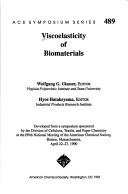
ISBN: 0841222215 Year: 1992 Publisher: Washington (D.C.) : American chemical society,
Abstract | Keywords | Export | Availability | Bookmark
 Loading...
Loading...Choose an application
- Reference Manager
- EndNote
- RefWorks (Direct export to RefWorks)
Reviews recent advances in the understanding of solid and liquid biomaterials and of viscoelastic solids and liquids. Includes discussions of the single material characteristic in biological materials of interest for structural uses (wood), and for nutritional uses (gels and gums) and medical purposes (artificial skins and membranes). Twenty-six chapters provide the reader with a perspective on the current state of knowledge of biomaterial science as it affects medical, nutritional, and structural fields of science.
Biomedical materials - Congresses. --- Viscoelasticity - Congresses. --- Biopolymers - Congresses. --- Biomedical materials --- Biopolymers --- Viscoelasticity --- Congresses.
Book
ISBN: 2855986346 Year: 1995 Publisher: Paris INSERM
Abstract | Keywords | Export | Availability | Bookmark
 Loading...
Loading...Choose an application
- Reference Manager
- EndNote
- RefWorks (Direct export to RefWorks)
Transplantation of organs, tissues, etc. --- Biomedical materials --- Biocompatibility
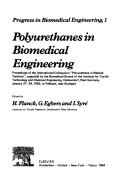
ISBN: 0444430164 9780444430168 0444423982 0444873473 9780444423986 9780444873477 Year: 1988 Volume: 6 Publisher: Amsterdam: Elsevier,
Abstract | Keywords | Export | Availability | Bookmark
 Loading...
Loading...Choose an application
- Reference Manager
- EndNote
- RefWorks (Direct export to RefWorks)
Biomedical materials --- Surfaces --- Congresses. --- Congresses --- Biomedical materials - Surfaces - Congresses. --- Oral medicine --- Biocompatible Materials --- Dental Implants --- Man --- Oral region --- Implants --- Polyurethanen. (Congres) --- Polymères / en médecine. (Congrès) --- Polyuréthane. (Congrès) --- Polymeren / in de geneeskunde. (Congres)
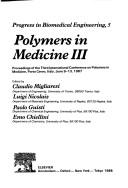
ISBN: 0444430032 9780444430038 Year: 1988 Volume: 5 Publisher: Amsterdam: Elsevier,
Abstract | Keywords | Export | Availability | Bookmark
 Loading...
Loading...Choose an application
- Reference Manager
- EndNote
- RefWorks (Direct export to RefWorks)
Polymers in medicine --- Biomedical materials --- Pharmaceutical Preparations --- Polymers --- Biocompatible Materials --- Congresses --- Drugs --- Biocompatible Materials - congresses. --- Polymers in medicine - Congresses --- Biomedical materials - Congresses --- Pharmaceutical Preparations - congresses --- Polymers - congresses --- Biocompatible Materials - congresses
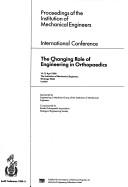
Abstract | Keywords | Export | Availability | Bookmark
 Loading...
Loading...Choose an application
- Reference Manager
- EndNote
- RefWorks (Direct export to RefWorks)
612.76 --- 617 --- #TWER:BIOM --- Locomotie. Beweging. Lichaamsmechanica. Biomedische ingenieurstechnieken --- Orthopedie. Oftalmologie --- Biomedical materials --- Congresses --- Biomedical engineering
Periodical
ISSN: 10974636 00219304 Year: 1967 Publisher: [New York, N.Y.] : John Wiley & Sons, Inc.,
Abstract | Keywords | Export | Availability | Bookmark
 Loading...
Loading...Choose an application
- Reference Manager
- EndNote
- RefWorks (Direct export to RefWorks)
Biomedical materials --- Biomedical materials. --- Biocompatible materials --- Biomaterials --- Medical materials --- Medicine --- Materials --- Biomedical engineering --- Biocompatibility --- Prosthesis --- Biomedical Engineering --- Bioartificial materials --- Hemocompatible materials --- Biomaterials (Biomedical materials) --- Human medicine --- Biocompatible Materials --- Materials Testing --- Biochemistry --- Biotechnology --- Chemistry. --- Cytology, Cell Biology. --- Life Sciences. --- Chemistry --- Health Sciences --- Life Sciences --- General and Others --- Cytology, Cell Biology --- Biomatériaux --- Périodiques --- MDTECHNO
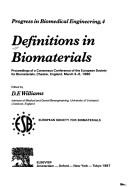
ISBN: 0444428585 9780444428585 Year: 1987 Volume: 4 Publisher: Amsterdam: Elsevier,
Abstract | Keywords | Export | Availability | Bookmark
 Loading...
Loading...Choose an application
- Reference Manager
- EndNote
- RefWorks (Direct export to RefWorks)
Biomedical materials --- Terminology --- Congresses --- -#TWER:BIOM --- Biocompatible materials --- Biomaterials --- Medical materials --- Medicine --- Biomedical engineering --- Materials --- Biocompatibility --- Prosthesis --- -Congresses --- #TWER:BIOM --- Terminology&delete& --- Matériaux biomédicaux. Terminologie anglaise. (Congrès) --- Biomedische materialen. Termen (Engelse). (Congres) --- Bioartificial materials --- Hemocompatible materials --- Biomaterials (Biomedical materials) --- Biomedical materials - Terminology - Congresses
Periodical
Abstract | Keywords | Export | Availability | Bookmark
 Loading...
Loading...Choose an application
- Reference Manager
- EndNote
- RefWorks (Direct export to RefWorks)
polymers --- Chemistry --- Polymere. --- Zeitschrift. --- Polymers --- Plastics --- Polymères --- Matières plastiques --- Periodicals. --- Périodiques --- Biomedical materials. --- Engineering --- Physical Chemistry --- Polymers and Plastics --- Civil Engineering --- Polymer Technology --- polymeren --- Polymers and polymerization --- Periodicals
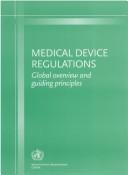
ISBN: 9241546182 0585492654 9786610060573 9240680950 1280060573 Year: 2003 Publisher: Geneva : World Health Organization,
Abstract | Keywords | Export | Availability | Bookmark
 Loading...
Loading...Choose an application
- Reference Manager
- EndNote
- RefWorks (Direct export to RefWorks)
Medical devices and equipment are a vital component of patient care. From a simple tongue depressor to a sophisticated haemodialysis machine, medical devices are needed at every level of the health service. Yet many health services continue to lack information and financial resources to acquire the devices they really need, i.e. those that will address the specific disease burden in their country. Effective implementation of a National Regulatory Authority is a first step towards the cost-effective management of medical devices that meet international quality and safety standards, throughout their entire life span, from conception to disposal. This publication offers countries a framework within which they can plan - or improve - their regulatory system for medical devices. Governments are particularly encouraged to take advantage of the extensive work undertaken over the last ten years by national and regional bodies to harmonize regulations on medical devices. Countries can also adopt the device approvals of the advanced regulatory systems. These two approaches alone can enable national health authorities to redirect scarce resources towards locally-assessed needs, such as vendor and device registration, training, surveillance and information exchange systems on medical devices in use.
Gestion des risques --- Gestion du risque --- Kwaliteitscontrole --- Maîtrise des risques --- Quality control --- Qualité [Contrôle de la ] --- Risicobeheer --- Risk management --- Risque -- Gestion --- Risques -- Gestion --- Equipment and supplies --- Legislation --- Standards --- Medical instruments and apparatus --- Biomedical materials --- Biocompatible materials --- Biomaterials --- Medical materials --- Medicine --- Biomedical engineering --- Materials --- Biocompatibility --- Prosthesis --- Standards. --- Bioartificial materials --- Hemocompatible materials --- Biomaterials (Biomedical materials)
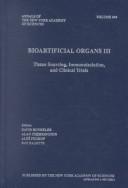
Abstract | Keywords | Export | Availability | Bookmark
 Loading...
Loading...Choose an application
- Reference Manager
- EndNote
- RefWorks (Direct export to RefWorks)
Beta adrenoceptors --- Beta adrénocepteurs --- Beta-adrenoceptoren --- Artificial organs --- Biomedical materials --- Blood substitutes --- Pancreatic beta cells --- Transplantation of organs, tissues, etc. --- Artificial Organs --- Biocompatible Materials --- Tissue Culture --- Transplantation Tolerance --- Transplantation --- Congresses --- Biocompatible materials
| Listing 1 - 10 of 22 | << page >> |
Sort by
|

 Search
Search Feedback
Feedback About UniCat
About UniCat  Help
Help News
News